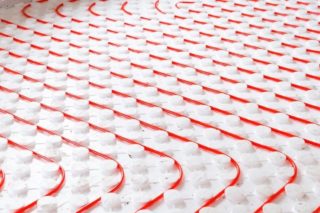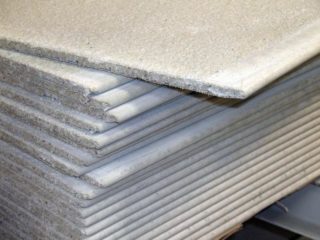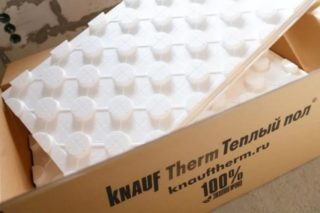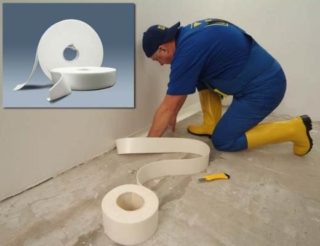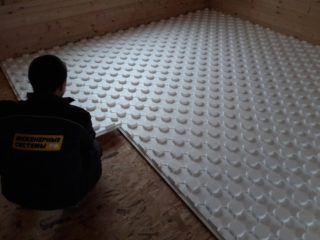Warm flooring is one of the effective ways to heat your home. Many well-known construction companies are engaged in the production of materials for creating a heating system, which include the German brand Knauf. They produce different types of underfloor heating with their own characteristics and features.
Types and characteristics of Knauf warm floors
The company is engaged in the production of two varieties of flooring - dry and mats for water heating. The first option is a multilayer structure consisting of vapor barrier or waterproofing, side edge tapes and expanded clay mixture. It has a simple installation, due to which a smooth and smooth coating is obtained. Typically, dry backfill is used for electric underfloor heating. From above, everything is covered with GVL cover plates, which are developed using Knauf technology.
Underfloor heating under water heating consists of expanded polystyrene mats with projections for pipes. Differs in simplicity of installation unlike a concrete coupler. In addition, the classic concrete screed has several disadvantages:
- The complexity and duration of the process. It is necessary to wait for complete drying.
- In case of technology violation, the screed is deformed and cracked.
- The complexity of dismantling.
- It is forbidden to use on wooden floors.
For this reason, a special bulk Knauf mixture is used for the wet floor, solving a number of problems:
- Facilitate the installation process and speed up the process. It is also easy to dismantle.
- Possibility of laying on wood flooring.
- Withstands significant loads.
- Sound absorption.
- Duration of operation. During use, the floor is not deformed.
- It does not burn, does not melt and does not emit harmful substances.
Knauf company has created a quality replacement for other types of subfloors.
Despite the excellent characteristics of Knauf coating, the technology has several disadvantages:
- The inability to use expanded clay mixture in rooms with high humidity.
- The formation of dust in the process of the device. The master must use personal protective equipment for the respiratory tract.
- Raising the floor by 6-8 cm due to the thick layer of the embankment.
Those who used the Knauf floor heating note possible surface deformations. But most often this is due to a violation of the styling technology.
Top Coat Selection
The embankment is covered with special GVL plywood, which is the development of Knauf. The abbreviation stands for gypsum fiber sheet. The material is treated with a special compound that protects the sheets from crumbling and moisture. Available with and without side edge.
Together with the topcoat, the kit contains an accompanying passport, in which you can find out all the characteristics of the material, information about the manufacturer, sheet sizes. They are also indicated on the back of the package. GVL meets international standards: it is non-combustible, does not emit toxic elements, does not melt, absorbs noise and is completely safe for human health and the environment. This is one of the best types of coatings for the Knauf bulk floor.
Heated floor for water heating
Water heating system imposes a number of conditions on the choice of components for underfloor heating. Knauf company has developed special polystyrene foam super durable mats for laying.This is an improved type of foam, which is characterized by increased resistance and strength. They have special recesses for laying the pipeline, which look like hats of nails. Plates perform the function of thermal insulation, because they are made of high density material.
An important advantage during installation is the ability to walk on the floor during work without subsequent deformations.
Basic properties:
- The protrusions provide for the installation of pipes of the most used diameters. They are placed with a specific step.
- Super strength material. Knauf thermo polystyrene withstands severe loads.
- Good thermal insulation properties and noise reduction.
- The presence of special locks and latches to simplify the installation process.
- Additional heat and waterproofing due to the reliability of the locks.
- The presence of markings, simplifying the cutting of plates.
- Does not emit toxic substances during operation.
- Melting point 180 ° C.
Recesses for pipes in case of deformation do not impair the functionality of the plate and the final result.
Essential tool
Before starting work, it is necessary to take measurements of the premises and purchase all materials and tools:
- Polyethylene film with a thickness of 200 microns. It will perform the function of waterproofing.
- Construction vacuum cleaner. It will help to collect garbage that is formed during the installation process.
- Paint brushes.
- Primer deep penetration.
- Scissors for metal.
- Leveling beacons.
- Building plaster.
- Spatulas.
- Self-tapping screws.
- Screwdriver.
PVA glue may also be required.
Installation of expanded polystyrene plates
Knauf therm floor heating panels are laid on top of a concrete screed. The algorithm of work:
- Removing the old coating. All structures must be dismantled to the supporting base. You do not need to align it.
- Surface preparation. It is necessary to remove debris and dust, putty in large holes and cracks.
- First you need to put a layer of thermal insulation, which will additionally protect water heating from heat loss.
- Bonding damping tape along the edge of the wall.
- Laying moisture-proof material or waterproofing on the insulation. This is a protective layer that protects the floor from leaks.
- Laying expanded polystyrene mats. Installation begins with thresholds. In the case of the delivery of pipes from another room, it is necessary to monitor the coincidence of locks and latches on the threshold of the room. To do this, the sheets are cut according to the marking applied on both sides.
- Delivery of heating pipes and laying them out in a predetermined sequence.
- Screed on top of mats with a special mixture from Knauf.
Work, including thermal insulation, takes several hours. The reliability of the floor is guaranteed by the manufacturer - it can withstand 140 kPa in the event of a linear effect on the sheets. Plates are available with different thicknesses, so before choosing you need to calculate which one is needed for this room.
Advantages of expanded polystyrene mats
Plates for water floor heating must meet all the requirements. The material from Knauf is made taking into account them and has the following advantages:
- Light weight. This is due to the material from which the Knauf floor mats are made. The entire structure is facilitated even with the presence of the pipeline and coolant in it, concrete screed, dynamic load during use.
- Creation of the strong, equal and reliable basis.
- Easy installation, high speed of work. The ease of work is the presence of markings on both sides of the mats, as well as the convenient location of latches and locks.
- A solid reliable coating that does not require additional gluing of cracks and joints.
- Optimum heat distribution over the entire floor surface.
- Environmentally friendly material.During use, harmful substances are not formed from it, mats are completely safe for health and the environment.
In case of observance of the rules of installation and operation, use time can reach 100 years. The disadvantages of the system include a high price, but it pays off during operation. For installation work does not require sophisticated professional equipment, which reduces costs.
